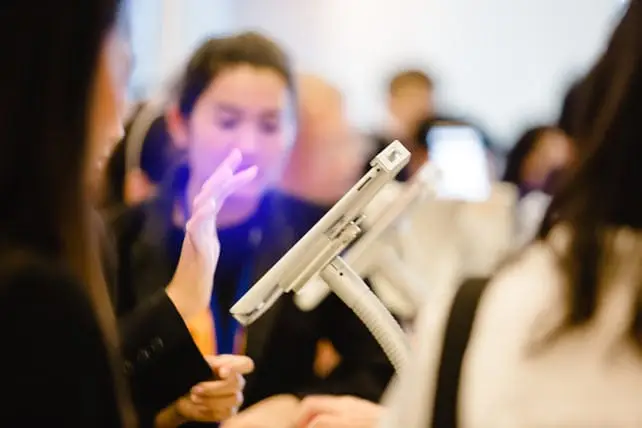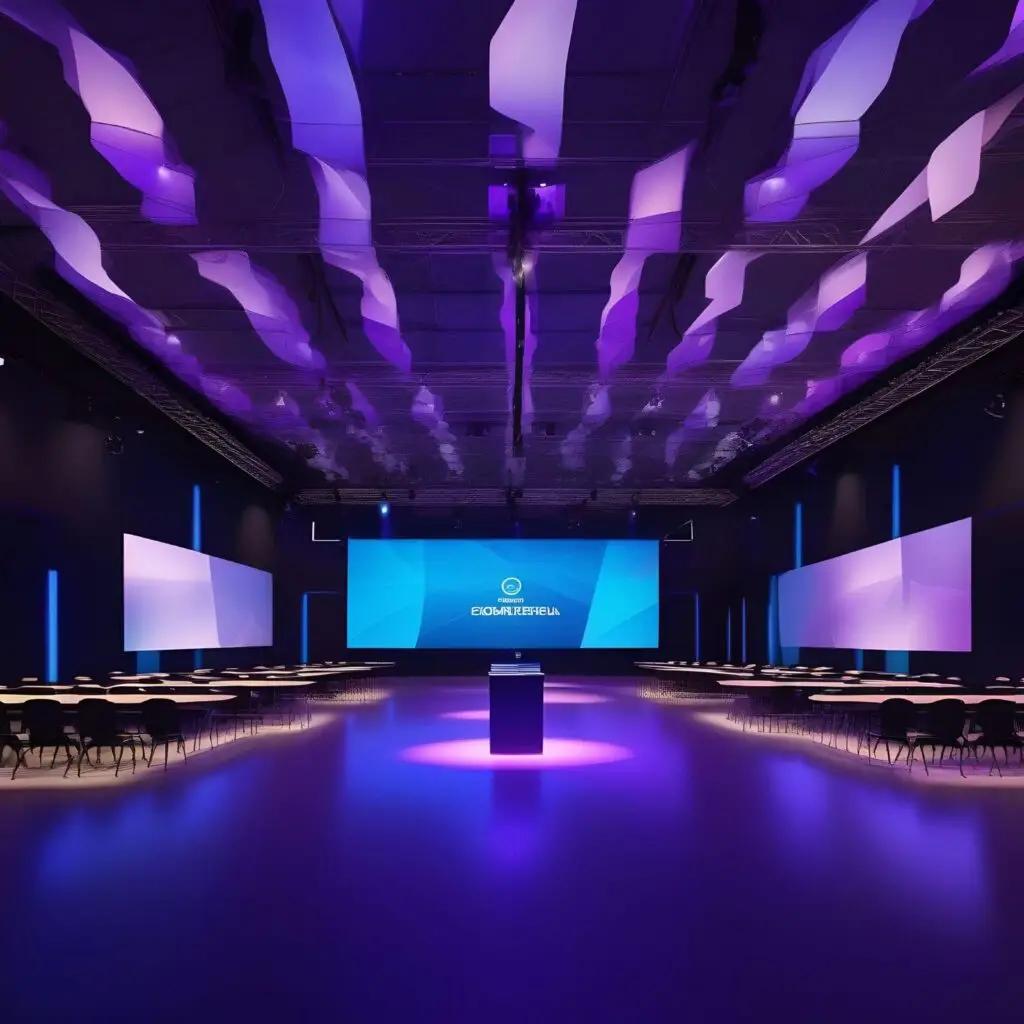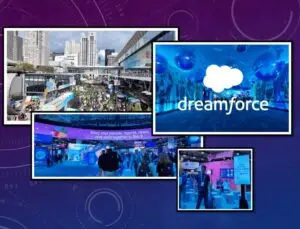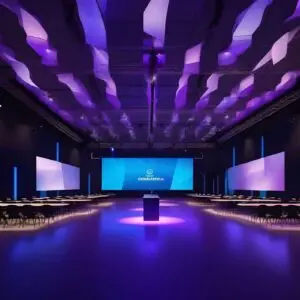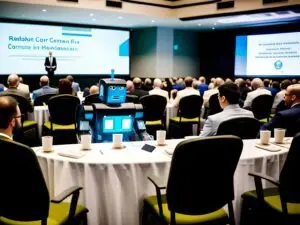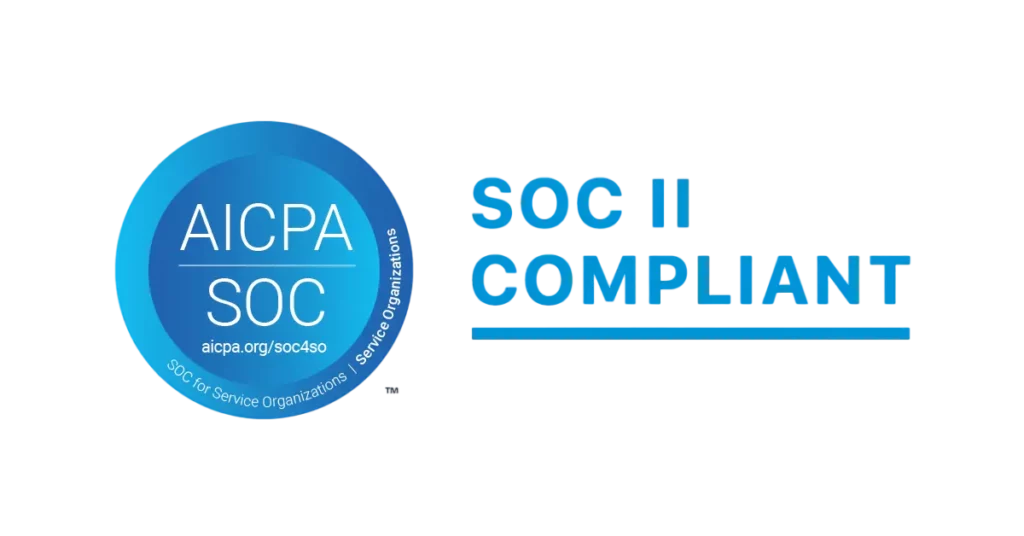Event industry statistics serve as a compass, guiding organizers, marketers and industry professionals through the complexities of planning, executing and measuring the impact of their events.
From the rise of virtual events to the strategic importance of sponsorships and metrics that illuminate ROI, we'll navigate the landscape of data-driven event statistics to uncover insights that empower event professionals to make informed decisions and chart the course for successful and impactful meetings.
General Event Statistics and Financial Growth
The event industry is undergoing a rapid evolution. Here are some of the most notable trends and recent insights in the event industry:
The events market was valued at $$5.6 billion by 2022a substantial increase of 37% from the $4.08 billion valuation in 2021. And event professionals have every reason to believe this trend will continue because:
- A study published in March 2023 indicated that three out of four professionals surveyed were confident of achieving better results than in the previous year, with 16% expressing extreme confidence and only 9% reporting doubts.
- Industry surveys also highlight a predicted growth in all sizes of meetings and events in 2024, with 78% anticipating an increase in the number of small and medium-sized meetings (fewer than 100 participants), while an equal number anticipate an increase in meetings with more than 100 participants.
- The industry is also optimistic about event-related revenue, with more than one-third (36%) of meeting professionals expecting a revenue increase of up to 50% over 2022 numbers in 2023.
- In fact, the research shows that the global event industry market is expected to reach a revenue of 2.1 trillion by 2032, exhibiting a compound annual growth rate (CAGR) of 6.4% from 2023 to 2032.
However, not everything is rosy:
Despite this optimistic outlook, the U.S. exhibition industry experienced a nearly 12% drop in revenue in Q1 2023 compared to Q1 2019.
Budget constraints are also a top concern, with 20% of respondents naming the potential for economic recession as a key factor of apprehension.
However, internal management challenges are one of the top issues facing the global exhibition industry, named by one-fifth of the companies surveyed. In addition, food and beverage price increases and higher audiovisual costs were the most problematic financial challenges for exhibition professionals globally.
However, the events industry is demonstrating a high level of adaptability, underscoring its resilience in a fast-moving world. The proof is in increased spending, despite industry-wide cost concerns and challenges:
In 2023, an average of 65% of companies worldwide experienced an increase in spending on meetings and events. One particularly encouraging aspect, highlighted by American Express, is that 10% of these companies report an increase of 11% or more in spending.
Survey data from event industry professionals aligns with this anticipated growth trend with a substantial 78% of respondents noting an increase in their own or their clients' spending since 2022 and 36% experiencing an increase of more than 25% in 2023. This growth trajectory is expected to persist in 2024, with 80% of surveyed experts anticipating an increase in spending. Notably, 30% anticipate an increase of more than 25%.
Face-to-Face Event Statistics
Despite the disruptions of the past few years, in-person events are seeing a strong rebound:
More than half of B2B marketers surveyed express a clear preference for attending in-person events over their virtual or hybrid counterparts, affirming the enduring value of direct interpersonal connections.
In fact, in-person meetings emerged as the predominant format for events in Q1 2023, with 70% of events and 87% of meetings taking place in person in 2023.
And an early 2023 survey showed that event professionals planned to participate in an average of 29.5 regional trade shows during the year, a slight increase from 28.6 in 2019.
In the United States, the value of the B2B trade show market reached US$10.17 billion in 2022. Projections indicate a growth trajectory, with expectations set at US$14.72 billion by 2027.
This renaissance even extends to the live music arena, where revenue from ticket sales and sponsorships is projected to reach $27 billion by 2026.
The preference for in-person events also aligns with the sentiments of attendees:
A staggering 65% of consumers say they understand a product or service better when they experience it through in-person events.
This resurgence of in-person events reflects a collective yearning for genuine connections, networking opportunities and the vibrant uniqueness that live experiences bring.
Virtual Event Statistics
Although face-to-face events have made a strong comeback, they are not diminishing the impact or importance of virtual events:
Despite the resurgence of in-person events, a remarkable 93% of event marketers express their intention to invest in virtual events in the foreseeable future.
A LinkedIn survey of more than 1,800 marketers in 13 countries revealed that 85% of respondents had organized virtual events in the past 12 months.
So why do people attend virtual events?
When analyzing the motivations behind attending virtual events, 57.2% of attendees emphasize their increased focus on learning in the digital realm.
In addition, virtual event participants identified demonstrations (26%), Q&A sessions with experts (19%) and keynote presentations (17%) as the most impactful types of virtual event sessions on their purchasing decisions.
What are event professionals thinking about virtuality?
Increased registrations stand out as the main benefit of virtuality. As indicated by 36% of respondents, followed by higher ROI (26%) and increased attendee participation (25.3%).
Increasing brand awareness is another main objective for event organizers' 28%.
In the B2B world, 45% of marketers considered live streaming the most crucial virtual offering for their events in 2022, followed by mobile access (38%) and enhanced branding opportunities (37%).
They are also thinking about revenue:
21% of event professionals cited revenue generation through ticket sales as the top priority for virtual events.
68% percent of event organizers reported charging for virtual events as of 2021 and had plans to continue to do so.
15% stated that they did not currently charge for virtual events but planned to do so in the future.
However, there are some drawbacks to virtual events:
On average, audiences only watch 68% of virtual events that last 20 minutes or more, underscoring the importance of creating concise and engaging content.
In addition, 58% of virtual events have 300 or fewer live attendees, pointing to the need for strategies to expand the reach and participation of virtual events.
Ultimately, navigating this evolving landscape means leveraging the unique advantages of both in-person and virtual events to create compelling and impactful experiences.
Hybrid Event Statistics
The versatility of hybrid events not only accommodates a wider virtual audience, but also preserves the essence of traditional in-person experiences, fostering meaningful connections. Combining the best of both worlds, hybrid events are increasingly gaining popularity:
62% percent of event organizers are committed to maintaining a virtual dimension to live events, anticipating that asynchronous hybrid events will be a significant trend.
Looking ahead, more than 50% of marketers envision a future where their events seamlessly accommodate both in-person and virtual audiences.
A substantial 59% of event marketers believe hybrid events will be crucial to their strategies in the future, and a staggering 97% of event professionals expect an increased prevalence of hybrid events in the future across the industry.
Of course, with this integration comes unique challenges:
- Hybrid event pricing is the top financial challenge, identified by three out of ten corporate event professionals.
- Striking a balance between the physical and digital experience is identified as an obstacle by nearly half of the marketers surveyed, underscoring the complexities of ensuring parity in the quality of both dimensions for a successful hybrid event.
It is clear that hybrid events are becoming integral to the fabric of event planning. Embracing this evolution requires addressing challenges to deliver seamless, inclusive and impactful experiences.
Event Technology Statistics
So what underpins this digital evolution? Innovative event technology, that's what:
62% of organizations recognize the critical role of virtual event technology in shaping their event strategies.
This recognition extends to practical implementation, with more than 81% of virtual event marketers leveraging event management tools to improve audience engagement and interaction.
40% of the companies surveyed focus on digital solutions for individual exhibits or products.
Nearly three-quarters of global marketers are using live streaming technology and an additional 20% expressed intentions to incorporate live video into their future strategies.
Not surprisingly, the rise of online experiences during 2020 will trigger fierce competition among video calling platforms:
- Zoom emerged as a clear winner, adopted by more than half of the companies surveyed for their video conferencing.
- Microsoft Teams secured the preference of just over one in ten organizations.
What other types of event technology are being used?
Digital business cards grew in popularity as a contactless networking solution during and after the pandemic.
Interestingly, event organizers 88% plan to incorporate virtual reality (VR), while 87% intends to leverage augmented reality (AR) for their events.
The benefits of event technology are multifaceted:
Implementation can increase attendance by 20% and improve productivity by 27%, according to industry data.
In addition, the 78% of event organizers who use mobile applications for events report a positive contribution to the return on investment (ROI) of the event.
What are the problems reported when using technology in events?
- A poor connection stands out as the main frustration with the 38%. For virtual and hybrid events.
- Poor microphones and mediocre cameras follow closely with 30% and 20%, respectively.
- There is a general feeling that a bad online experience generates a loss of registrations of up to 20%.
- Poor registration and check-in technology that creates lines and waits reduces overall event satisfaction by as much as 15%
In navigating this transformative landscape, event professionals must strike a delicate balance between leveraging digital innovations and mitigating the challenges inherent in the evolving field of event technology.
B2B Event Industry Statistics
Companies are aware of the power of events to drive success, especially when it comes to selling to other companies:
54% of B2B event professionals plan to organize more events in the coming year, and...
- Insights from a LinkedIn study reveal that 45% of future B2B events are anticipated to be entirely virtual.
- In fact, B2B companies are already allocating 10 to 20% of their annual marketing budget to virtual events.
- This is probably why the global events industry is projected to generate $1.46 billion in revenue by 2028, representing a remarkable compound annual growth rate (CAGR) of 23.1% from 2021 to 2028.
Navigating the B2B event space comes with its share of challenges. Especially:
The 90% of B2B event organizers identify reaching a new audience and securing sponsors as the two main obstacles they face.
These points underscore the evolving nature of the B2B event landscape in terms of revenue, audience growth and adoption of virtual solutions.
Event Marketing Statistics
The role of effective event marketing cannot be underestimated:
52% of companies believe that events provide the highest ROI compared to other marketing channels.
Research also shows that events such as trade shows can help increase brand recognition by 76%.
In-person events are the most popular marketing channel, with 60% of B2B marketers planning to use this channel in 2023.
These facts make event marketers optimistic with approximately 43% reporting that they feel confident about the effectiveness of trade show marketing.
From driving sales to cultivating lasting customer relationships, event marketing has a tangible impact and is a pivotal contributor to revenue growth.
Attendee Participation Statistics
Attendee participation takes center stage as a decisive factor in the success of the event:
More than 82% of B2B marketers consider attendee engagement to be an important key performance indicator (KPI) in determining the impact of an event.
Similarly, nearly half of large event organizers rely on related participation metrics, such as total number of registrations and attendances, as key indicators of effectiveness.
But it's not just about keeping attendees happy; it's about making sure attendees have what they need to get the most out of each event. To that end, 87% of planners actively strive to incorporate diversity, equity and inclusion (DE&I) into their meetings and events.
However, participation is not always an easy path:
- Despite its recognized importance, 67% of event marketers find it challenging to keep attendees engaged during virtual events.
- Even before an event begins, participation is an issue, with a growing trend in last-minute event registrations presenting a challenge for event professionals.
- In addressing this challenge, 63% of event marketers believe that leveraging attendee engagement tools can play a crucial role in their event marketing strategies.
Planners are also focusing more on the individual needs of attendees, creating smaller, exclusive and boutique events, or micro events within macro events to offer an exclusive and premium experience for attendees. In 2023, approximately one in five companies expressed a plan to increase spending on VIP events for clients in 2023 and beyond.
The metrics and challenges ultimately paint a nuanced picture of the evolving expectations and complex dynamics that drive attendee participation in a variety of event contexts.
Event Sponsorship Statistics
Sponsorship is an essential part of the financial fabric of events:
- More than 45% of marketers plan to increase their event sponsorship budgets in the coming year.
- And, despite the disruptions of recent years, U.S. event sponsorship budgets are recovering, with a projected 18% increase by 2024.
It's not just a question of money, however. Sponsors are looking for greater exposure and recognition:
More than 50% of sponsors see events as an opportunity to enhance brand recognition, while nearly 40% seek to generate new business and 34% pursue attendee engagement goals.
However, not all events offer the expected return on investment:
Nearly half of event marketers (45%) are struggling to justify the return on investment (ROI) of sponsored events.
This highlights the need for clear alignment between sponsor objectives and event marketing strategies to ensure an effective and mutually beneficial partnership.
Conclusions
The world of events is complex and dynamic, with rapid change and continuous evolution. However, through challenges and opportunities, one thing is certain: events will continue to be a powerful force for change, connection and growth for years to come. With an informed understanding of current trends, statistics and best practices, event professionals can navigate this changing landscape with confidence, building meaningful and enduring experiences for their audiences, sponsors and brands.
Sources:

